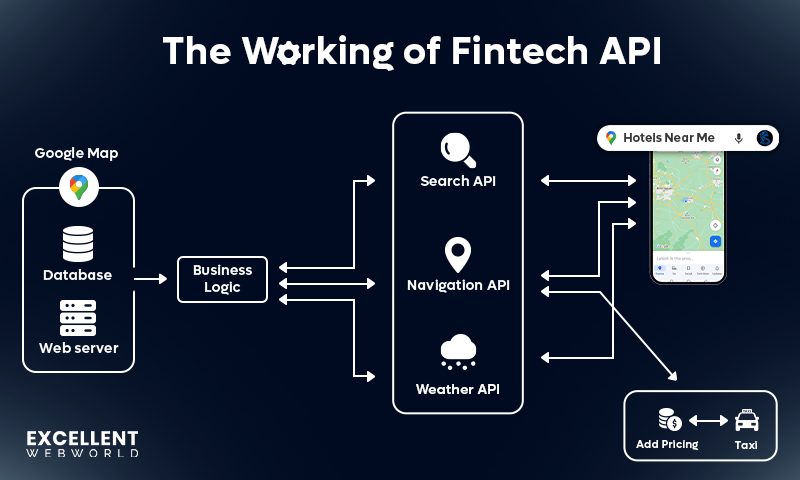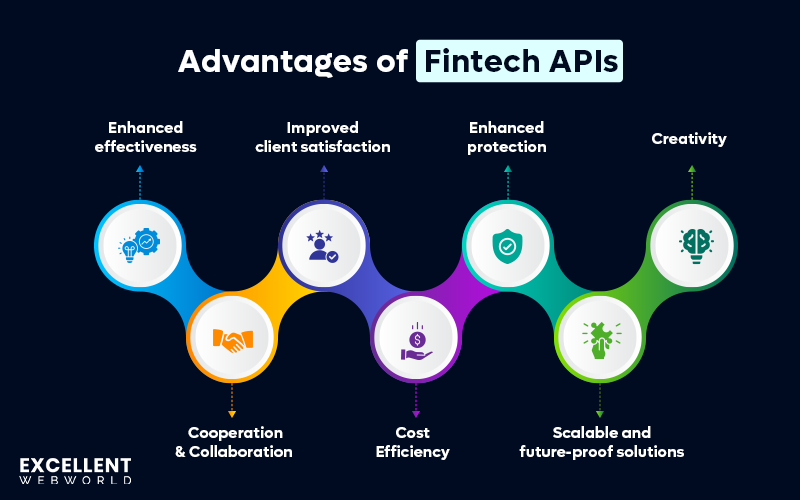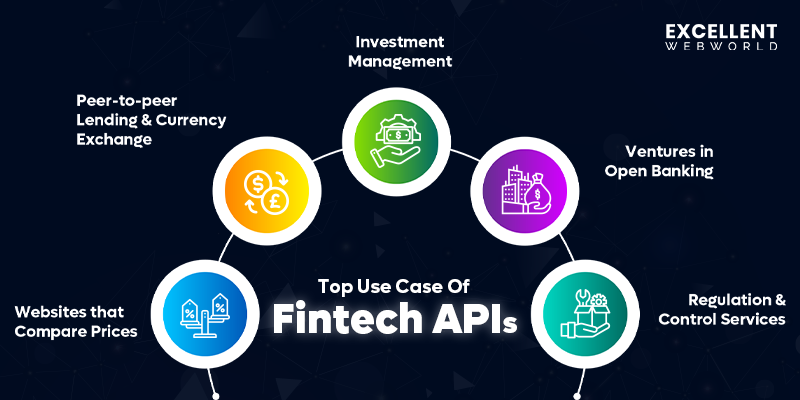If you think of APIs as just “connectors” for your fintech solutions, then you are wrong, and your competitors are so ahead of you.
Fintech APIs are not just infrastructure; they are the crucial solvent to beat this competitive edge. From AI-powered risk engines to processing real-time payments and building hyper-personalized financial solutions, APIs manage everything from the backend of fintech products.
At Excellent Webworld, we’ve helped our clients build fintech products that process millions of API calls on a daily basis with real-time data, AI algorithms, and secure payment rails. That’s why we know how API-first development makes scalable integrations and AI-enhanced decision-making possible.
In this blog, we have curated the top use cases of fintech APIs and the hidden benefits of using them to become a market leader. Also, you will understand why those who ignore this tech layer now risk becoming irrelevant tomorrow.
What Are Fintech APIs?
Fintech API combines two words: “Fintech” and “API.” The Oxford Dictionary defines fintech as “computer programs and other tech used to enable banking and financial services.” But then, what is an API? Application Programming Interface (API) allows banks and financial services to integrate Fintech solutions into their systems. Software components can interact and communicate programmatically by adhering to rules defined by APIs. A particular kind of API known as a fintech API enables companies to include banking and financial services elements into their apps.
API for Fintech are software tools that facilitate communication and data sharing across various systems and applications. They enable banks, business owners, and engineers to develop innovative fintech apps and services that leverage financial data and resources. They provide safe information sharing between various financial systems, including trading platforms, banks, and payment processors. Today, there are several Fintech API examples to prove the importance of these tech in town.
For instance, a fintech firm might access client account information and start transactions via an API that a bank provides, saving them from having to start from scratch with their own infrastructure. In a similar vein, financial advisors may use it to get access to current market data and give their customers individualized investment recommendations.
Why Are APIs in Fintech So Important Today?
The standardization of data sharing and communication across diverse systems can facilitate the development of new applications and services by financial firms more efficiently and promptly. Consequently, this enables businesses to launch new items faster, refine them faster, and react to shifting consumer demands and market dynamics more skillfully.
More communication between various financial systems is also made possible via APIs, which benefits businesses and customers by facilitating credit access, money transfers, and financial management across a variety of platforms and services.
These tools offer greater security and transparency in the financial sector in addition to accelerating innovation and enhancing interoperability. Clear interfaces for data access and exchange are provided via APIs, which can aid in lowering the possibility of mistakes, fraud, and other security risks.
How do Fintech APIs Work?
Wondering how do financial APIs work? An API for banking or financial use is just as sophisticated and technologically advanced as fintech software. There are multiple processes involved in getting a fintech application to work with an API.
Apart from the necessary procedures to establish the link between a financial application and application programming interface in banking industry, the characteristics of a financial API necessitate supplementary risk mitigation and security protocols. For example, fintech API providers are bound by industry laws designed to regulate financial institutions and fintech companies, and encryption is frequently used to safeguard sensitive data transferred over financial APIs.
What Are the Top Benefits of APIs in Fintech?
We’ve already covered the significance of API technology for the finance industry. Let us tell you what the top advantages of Fintech APIs are that we have served to our clients and that your company can also have if you choose to employ these solutions.
1. Enhanced effectiveness
Application programming interfaces can make financial activities more automated and efficient. This reduces the need for human interaction, ultimately increasing overall productivity. Customers may find financial services easier to use, enhancing their convenience. Financial institutions can save money using automation driven by the integration of AI in Fintech apps. APIs streamline processes, leading to faster transactions and fewer errors.
2. Improved client satisfaction
Within the financial sector, Fintech API development plays a major role in improving the consumer experience. They make it possible to develop financial services and applications that are more individualized, simple to use, and intuitive. Customers will be able to readily access and engage with their financial data in novel and creative ways, which might result in a more enjoyable user experience.
Additionally, by easing the fintech integration of various financial systems, these tools help consumers transfer funds, obtain loans, and handle their money through a variety of channels and nfc platforms. Customers may find this more convenient overall and less of a hassle, which will increase their pleasure and loyalty.
3. Enhanced protection
The likelihood of mistakes, fraud, and other security risks is decreased by putting the required APIs into place. Application programming interfaces have the potential to facilitate more transparent and safe data sharing between financial institutions and other relevant parties, thereby streamlining the process of tracking and monitoring financial activity and transactions.
4. Creativity
Fintech APIs facilitate more engineering and financial institution experimentation and collaboration, enabling quick iteration and AI-based automated testing of new concepts and goods. They can also help the financial sector incorporate cutting-edge technology like blockchain and artificial intelligence services to creating new avenues for expansion and advancement.
5. Cooperation & Collaboration
Fintech services use APIs to facilitate quick data sharing and analysis, which enables stakeholders to collaborate to find new opportunities and resolve challenging issues. They also encourage the growth of collaborative models such as open banking, in which financial institutions work with outside developers to develop new value-added services by sharing data and functionality.
6. Cost Efficiency
APIs can eliminate the need for expensive and time-consuming custom Fintech API integrations and manual data entry by establishing a standard for data access and exchange. Additionally, since fintech app developers may design new apps and services using pre-existing code and functionality rather than starting from scratch, they can aid in lowering IT expenses. This can shorten the time it takes for innovative and AI-driven fintech solutions to reach the market and reduce development expenses.
7. Scalable and future-proof solutions
These days, with its widespread use, it’s safe to conclude that API technology is here to stay. On the contrary, it will play an even bigger role in the creation of financial apps as more businesses choose to use lightweight and accessible APIs instead of traditional development. This will only increase the apps’ quality, functionality, and diversity. Moreover, projects that are anticipated to grow and extend over time are ideally suited for Fintech API development and integration.
What Are the Best Use Cases of APIs in Fintech?
Examining how APIs are used in the banking sector reveals a number of real-world scenarios in which they are extremely beneficial. Below, let’s take a closer look at the FinTech application cases for APIs:
1. Websites that Compare Prices
In the FinTech sector, price comparison websites such as MoneySuperMarket have embraced APIs to become a direct online distributor of financial products. The website powers its websites with built-in API service layers, which also facilitate the expansion of business collaborations. The company is able to give its consumers better services and experiences because it has a single view of them across all of their important interactions.
2. Peer-to-peer Lending and Currency Exchange
P2P network innovation emerged from the overwhelming demand for transactional process simplification. Financial institutions now offer thousands of P2P payment apps that provide a wide range of services.
This idea has now at last found application in currency trading. FinTech companies have ample potential to grow since orders for buying and selling currencies are spread among interested clients, with some orders wiping out others (for example, an order to buy dollars that will be canceled with a subsequent sale from another user). With and advanced payment API, FinTech businesses like TransferWise have figured out how to do rid of the middlemen in this process.
Read More: How to Build a Peer-to-Peer Payment Apps?
3. Investment Management
Financial advisors found it difficult to obtain the client’s information in order to provide optimum services prior to open banking. Nevertheless, access to an individual’s portfolio information is now possible through investment management APIs, doing away with the need to estimate or piece together a client’s assets and net worth from a variety of sources.
4. Ventures in Open Banking
ING is one of the few companies considering the idea of starting a number of separate businesses with the goal of developing new products that will eventually be connected with the aid of APIs. They provide three products: a digital wallet called Payconiq, a personal finance management aggregator called Yolt, and an aggregator of financial services. Additionally, the business discovered how to use an API-based developer site to communicate with outside developers.
5. Regulation & Control Services
These days, fintech and regtech go hand in hand, particularly when it comes to using open APIs from third parties. Verifying the user’s identification is crucial when providing a wide range of banking and financial services. This cannot be negotiated because the open banking ecosystem as a whole depends on user data that they have consented to provide. Therefore, the institutions need to provide strong verification.
RegTech APIs and AI integrations can provide answers in this situation. They provide a variety of programs, including KYC, iris scanning, and biometric identification. It improves user experience and helps prevent repetitive form filling. Trulioo is a prime example of a FinTech API; it provides an API for confirming customer information using a JSON interchange.
What Are the Biggest Challenges And Risks of APIs in Fintech?
Since there are risks involved in nearly every step of the fintech development process, you and your team should be aware of the potential difficulties that API interfaces may present.
1. Concerns about security and data privacy
Since sensitive data is frequently sent between various systems via APIs, security lapses and hacks may be possible. For example, hackers could be able to get credit card numbers or other sensitive financial information if an API is not sufficiently secured.
2. Technical intricacy
Technical intricacy is another issue with fintech’s use of APIs. Because APIs are frequently created with a variety of web development languages and frameworks, bank API integration and maintenance can be difficult and time-consuming.
Additionally, APIs must be carefully considered in terms of their usefulness and compatibility with various systems during the design process, which calls for specific knowledge and resources. Smaller fintech businesses may find this especially difficult because they lack the funding and technical know-how necessary to develop and maintain sophisticated APIs.
3. Adherence to regulations
Due to the communication of sensitive financial data between various systems and the potential involvement of third-party service providers who may be subject to additional regulatory requirements, APIs have the potential to complicate regulatory compliance.
Regulations unique to certain industries, such as those controlling investment management or payment processing, may also need to be complied with by APIs. A detailed grasp of the regulations pertaining to their APIs is required in order to reduce the risks. It will guarantee that all relevant laws and regulations are followed.
What Does the Future Hold for Fintech APIs?
Modern and AI-powered fintech systems cannot function without APIs, which let financial institutions and fintech startups work together to develop cutting-edge new goods and services.
Fintech companies reap numerous advantages by utilising APIs, such as heightened productivity, better client satisfaction, heightened security, and chances for cooperation and innovation. APIs do, however, come with dangers and difficulties, such as issues with security and data privacy, technical complexity, and legal compliance.
If you are looking for an experienced partner that can help you build your visionary fintech solution, then Excellent Webworld should be your first choice. As we are rated the #1 fintech app development company, our team helps you build the best of the best fintech apps with API integration. Get in touch with our experts for more information.
Read More: A Complete FinTech Startup Guide
Frequently Asked Questions:
Basically, there are 4 main types of API;
APIs enhance financial services by enabling seamless integration of third-party services, boosting innovation, and improving user experiences. They allow for automated processes, reducing manual intervention, which speeds up transactions and enhances security.
APIs also enable personalized financial products, catering to individual needs, and support the expansion of digital ecosystems by integrating new technologies like AI and blockchain.
There isn’t a one-size-fits-all answer to this, as the best API depends on specific needs. However, Plaid is highly regarded for its robust and secure integration of banking data, making it a top choice for many fintech companies. For payments, Stripe’s API is often cited as the best for its ease of use, comprehensive features, and strong developer support.

Article By
Mayur Panchal is the CTO of Excellent Webworld. With his skills and expertise, He stays updated with industry trends and utilizes his technical expertise to address problems faced by entrepreneurs and startup owners.



